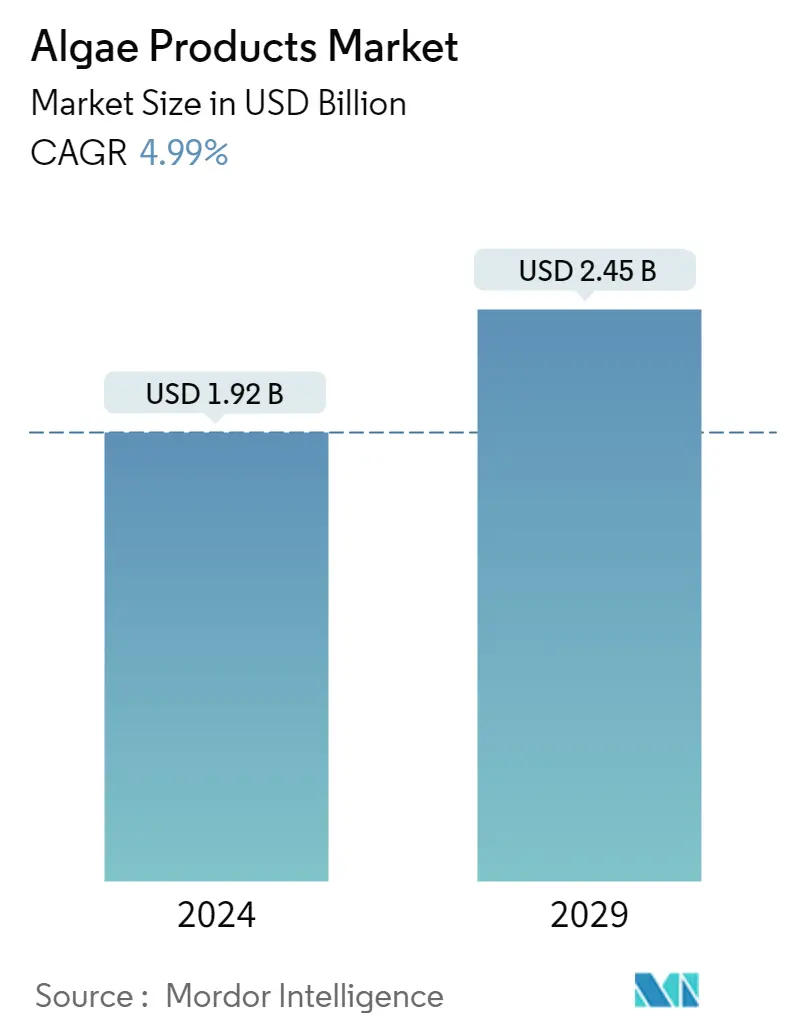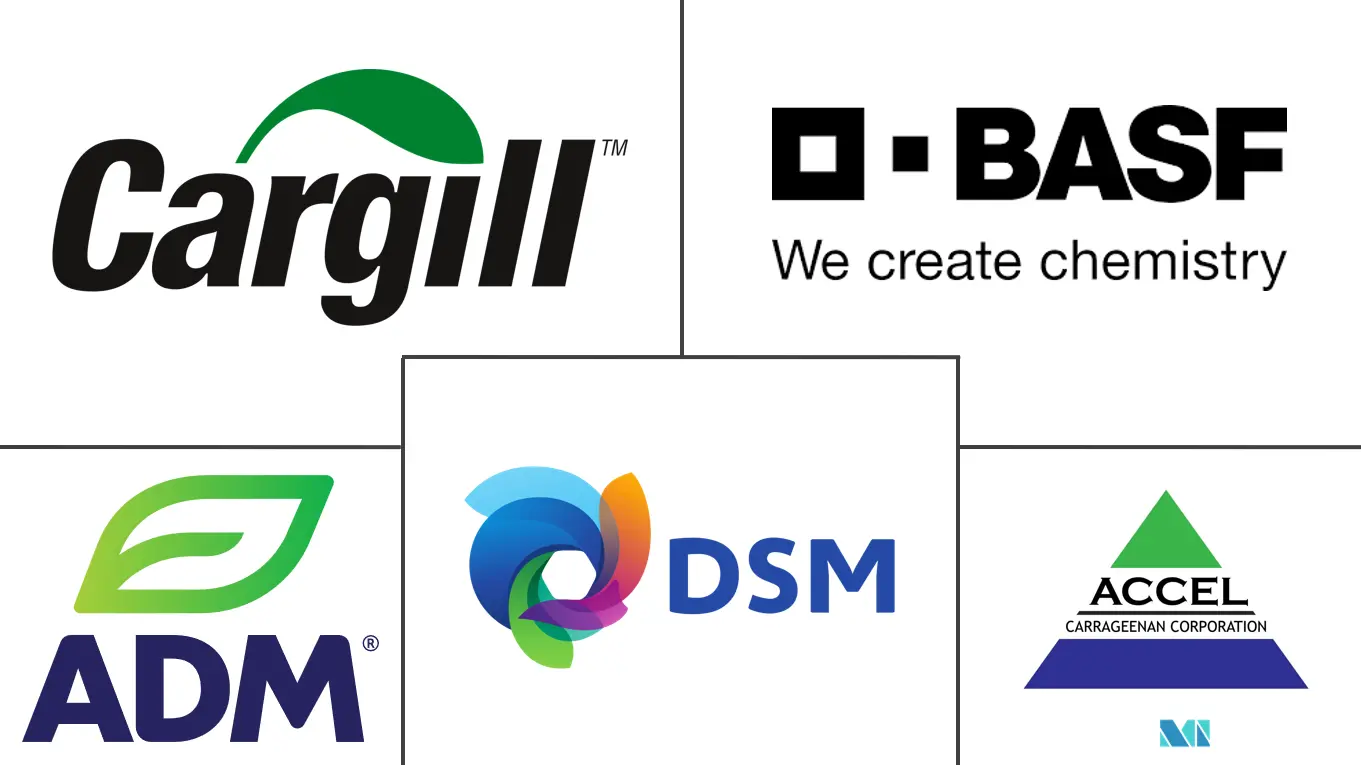Market Size of Algae Products Industry

| Study Period | 2018 - 2029 |
| Market Size (2024) | USD 1.92 Billion |
| Market Size (2029) | USD 2.45 Billion |
| CAGR (2024 - 2029) | 4.99 % |
| Fastest Growing Market | Asia Pacific |
| Largest Market | North America |
Major Players
*Disclaimer: Major Players sorted in no particular order |
Algae Products Market Analysis
The Algae Products Market size is estimated at USD 1.92 billion in 2024, and is expected to reach USD 2.45 billion by 2029, growing at a CAGR of 4.99% during the forecast period (2024-2029).
The algae products market is driven by changing dietary preferences and the paradigm shift toward preventive health management practices amid rising healthcare costs and the increasing burden of lifestyle-related diseases. The growing geriatric population, coupled with the rising prevalence of chronic conditions, is anticipated to drive the growth of algae products worldwide. Moreover, consumer awareness about botanical variants and their functional properties has been a critical driver. As algae also support immunity development, the post-COVID-19 situation is predicted to witness steep sales of algae supplements
Algae have wide applications as functional ingredients in various food products as they are rich in essential oils such as omega-3 fatty acids and poly-unsaturated fatty acids (PUFA). Omega-3 fatty acids and PUFA are widely used in health food products and pharmaceuticals. Algae products are also being used in renewable raw materials for biofuels. According to the Department of Energy, algae can provide at least 30 times more energy than land-based crops currently utilized to make biofuels. Algae may also effectively recycle atmospheric carbon, making them an ideal environmentally beneficial energy source. Moreover, with the discovery of the potential of algal oil as a renewable fuel source, many petro-based companies, including Exxon, Shell, BP, Statoil, ENAP, and Chevron, are investing in biofuel R&D to produce methanol, ethanol, bio-butanol, biodiesel, and biocrude, as well as bio-based chemicals, thereby, augmenting the market growth.
North America holds the largest share of the algae products market due to a high level of consumer awareness about the nutritional benefits of the ingredient. By source, brown algae account for the largest market share.
Algae Products Industry Segmentation
Algae products are single-celled, aquatic, plant-like substances with rich nutrition. They are used in dietary supplements, personal care, and pharmaceuticals. The algae products market is segmented by source, product type, application, and geography. Based on the source, the market is segmented into Brown Algae, Red Algae, Green Algae, and Blue-green Algae. Based on product type, the market is segmented into Algal Protein, Alginate, Carrageenan, Carotenoids, Lipids, and Other Product Types. Based on application, the market is segmented into Personal Care, Food and Beverage, Dietary Supplements, Pharmaceuticals, Animal Feed, and Other Applications. Based on geography, the market is segmented into North America, Europe, South America, Asia Pacific, and Middle-East & Africa). For each segment, the market sizing and forecasts have been done on the basis of value (in USD million).
| Source | |
| Brown Algae | |
| Red Algae | |
| Green Algae | |
| Blue-green Algae |
| Product Type | |
| Algal Protein | |
| Alginate | |
| Carrageenan | |
| Carotenoids | |
| Lipids | |
| Other Product Types |
| Application | |
| Personal Care | |
| Food and Beverage | |
| Dietary Supplements | |
| Pharmaceuticals | |
| Animal Feed | |
| Other Applications |
| Geography | |||||||||
| |||||||||
| |||||||||
| |||||||||
| |||||||||
|
Algae Products Market Size Summary
The algae products market is experiencing significant growth, driven by shifting dietary preferences and an increasing focus on preventive health management due to rising healthcare costs and lifestyle-related diseases. The expanding geriatric population and the prevalence of chronic conditions are further propelling the demand for algae products globally. Consumer awareness of the functional properties of botanical variants, including algae, is a key factor in this growth. The post-COVID-19 environment is expected to see a surge in sales of algae supplements, as they are known to support immunity. Algae are increasingly used as functional ingredients in food products, particularly for their rich content of omega-3 fatty acids and poly-unsaturated fatty acids, which are popular in health foods and pharmaceuticals. Additionally, algae are being explored as renewable raw materials for biofuels, offering a sustainable energy source with the potential to recycle atmospheric carbon.
North America currently holds the largest share of the algae products market, attributed to high consumer awareness of the nutritional benefits of algae. Brown algae dominate the market by source, and algae, including microalgae, are utilized in various applications such as dietary supplements, cosmetics, functional foods and beverages, and animal feed. The Asia-Pacific region is projected to witness the fastest growth, driven by the rising consumption of nutraceuticals and government initiatives in countries like India. Major global players, including Kerry, Cargill, and ADM, are expanding their production capacities and strengthening distribution relationships to capture market share. Recent strategic moves, such as the acquisition of a chlorella algae facility by Aliga Microalgae and the expansion of DSM's algal-sourced omega-3 product line, highlight the industry's focus on innovation and market expansion.
Algae Products Market Size - Table of Contents
-
1. MARKET DYNAMICS
-
1.1 Market Drivers
-
1.2 Market Restraints
-
1.3 Porter's Five Forces Analysis
-
1.3.1 Threat of New Entrants
-
1.3.2 Bargaining Power of Buyers/Consumers
-
1.3.3 Bargaining Power of Suppliers
-
1.3.4 Threat of Substitute Products
-
1.3.5 Intensity of Competitive Rivalry
-
-
-
2. MARKET SEGMENTATION
-
2.1 Source
-
2.1.1 Brown Algae
-
2.1.2 Red Algae
-
2.1.3 Green Algae
-
2.1.4 Blue-green Algae
-
-
2.2 Product Type
-
2.2.1 Algal Protein
-
2.2.2 Alginate
-
2.2.3 Carrageenan
-
2.2.4 Carotenoids
-
2.2.5 Lipids
-
2.2.6 Other Product Types
-
-
2.3 Application
-
2.3.1 Personal Care
-
2.3.2 Food and Beverage
-
2.3.3 Dietary Supplements
-
2.3.4 Pharmaceuticals
-
2.3.5 Animal Feed
-
2.3.6 Other Applications
-
-
2.4 Geography
-
2.4.1 North America
-
2.4.1.1 United States
-
2.4.1.2 Canada
-
2.4.1.3 Mexico
-
2.4.1.4 Rest of North America
-
-
2.4.2 Europe
-
2.4.2.1 Spain
-
2.4.2.2 United Kingdom
-
2.4.2.3 Germany
-
2.4.2.4 France
-
2.4.2.5 Italy
-
2.4.2.6 Russia
-
2.4.2.7 Rest of Europe
-
-
2.4.3 Asia-Pacific
-
2.4.3.1 China
-
2.4.3.2 Japan
-
2.4.3.3 India
-
2.4.3.4 Australia
-
2.4.3.5 Rest of Asia-Pacific
-
-
2.4.4 South America
-
2.4.4.1 Brazil
-
2.4.4.2 Argentina
-
2.4.4.3 Rest of South America
-
-
2.4.5 Middle-East and Africa
-
2.4.5.1 South Africa
-
2.4.5.2 United Arab Emirates
-
2.4.5.3 Rest of Middle-East and Africa
-
-
-
Algae Products Market Size FAQs
How big is the Algae Products Market?
The Algae Products Market size is expected to reach USD 1.92 billion in 2024 and grow at a CAGR of 4.99% to reach USD 2.45 billion by 2029.
What is the current Algae Products Market size?
In 2024, the Algae Products Market size is expected to reach USD 1.92 billion.

